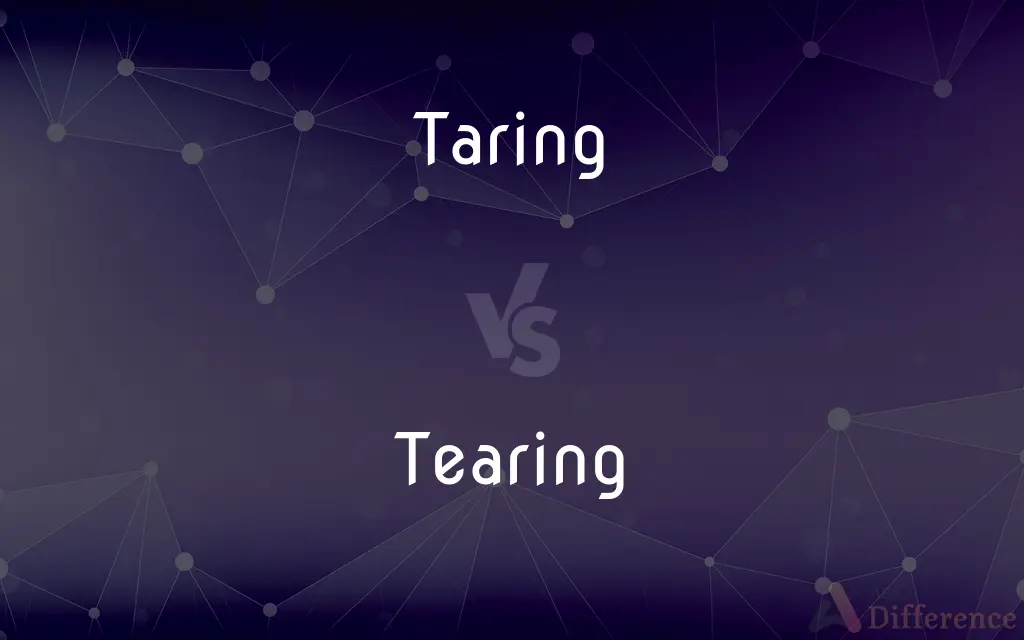Taring vs. Tearing — What's the Difference?
By Maham Liaqat & Fiza Rafique — Updated on May 5, 2024
Taring involves setting a scale to zero to weigh the net content, while tearing refers to ripping or splitting material apart.

Difference Between Taring and Tearing
Table of Contents
ADVERTISEMENT
Key Differences
Taring is a process used in weighing that involves adjusting the scale's reading to zero with an empty container on it, ensuring that the weight measured is only that of the contents added thereafter. On the other hand, tearing describes the act of physically ripping or splitting something into parts, often using hands or tools.
While taring is a deliberate action to facilitate accurate measurements, tearing is generally either an intentional act of separating materials or an accidental result of force.
Taring is crucial in various industries to ensure precise ingredient amounts in recipes or correct chemical quantities in laboratories. Conversely, tearing is a physical action observed in everyday activities like opening packaging or in destructive actions like fabric ripping.
Taring requires a specific tool, namely a scale, and is a non-destructive, reversible action. In contrast, tearing typically results in irreversible damage to the object being torn.
Taring is about precision and preparation in measurement, whereas tearing often involves a degree of immediate physical alteration.
ADVERTISEMENT
Comparison Chart
Definition
Adjusting a scale to zero to weigh contents.
Physically ripping or splitting something.
Purpose
Ensure accurate measurements.
Separate or open materials.
Tools Required
Scale.
Hands or tools (like scissors).
Industries Involved
Food, pharmaceuticals, logistics.
Textile, packaging, personal use.
Nature of Action
Non-destructive and reversible.
Often destructive and irreversible.
Compare with Definitions
Taring
Adjust the scale for container weight.
The pharmacist tared the bottle to ensure the medicine's weight was accurate.
Tearing
Rip paper into pieces.
She was tearing up old letters for recycling.
Taring
Routine in laboratory settings.
Daily taring of balances is standard in laboratory protocols.
Tearing
Opening packaging by hand.
He tore open the snack bag from the top.
Taring
Preparation for precise measurements.
Taring the scale is essential before adding ingredients for the recipe.
Tearing
Destructive separation of materials.
Tearing the poster off the wall left marks.
Taring
Calibration step in weighing.
Taring is a crucial calibration step to ensure accuracy.
Tearing
Split fabric manually.
The seamstress avoided tearing the delicate silk by using sharp scissors.
Taring
Zero out a scale.
He tared the scale before weighing the coffee beans.
Tearing
Result of physical force.
The banner was tearing under the strain of the wind.
Taring
The weight of a container or wrapper that is deducted from the gross weight to obtain net weight.
Tearing
Tearing is the act of breaking apart a material by force, without the aid of a cutting tool. A tear in a piece of paper, fabric, or some other similar object may be the result of the intentional effort with one's bare hands, or be accidental.
Taring
A deduction from gross weight made to allow for the weight of a container.
Tearing
Marked by great or violent haste
A tearing hurry.
Taring
(Chemistry) A counterbalance, especially an empty vessel used to counterbalance the weight of a similar container.
Tearing
Present participle of tear
Taring
To determine or indicate the tare of, especially to weigh in order to find out the tare.
Tearing
(colloquial) enormous; of great size or impact
A tearing great giant of a man
Taring
Present participle of tare
Tearing
(colloquial) very hasty
A tearing hurry
Taring
The common tern (Sterna hirundo).
Tearing
The act by which something is torn; a laceration.
Taring
The common tern; - called also tarret, and tarrock.
Tearing
(computer graphics) Distortion of an animated display when the contents of the framebuffer are rendered while it contains portions of two or more frames.
Tearing
(medicine) continuous shedding of tears; epiphora
Tearing
Shedding tears
Tearing
Marked by extreme intensity of emotions or convictions; inclined to react violently; fervid;
Fierce loyalty
In a tearing rage
Vehement dislike
Violent passions
Common Curiosities
What is the purpose of taring a scale?
To ensure only the net weight of the contents is measured, not including the container.
What materials are commonly torn?
Fabrics, paper, and thin plastics are commonly torn materials.
How does taring affect recipe accuracy?
It ensures ingredients are measured precisely, affecting the outcome of the recipe.
Can tearing be accidental?
Yes, materials can tear accidentally due to excessive force or wear.
Can tearing be part of a creative process?
Yes, artists and designers might intentionally tear materials as part of their creative expression.
Are there specific techniques for tearing effectively?
Yes, using the hands properly or tools like scissors can ensure clean tears.
What industries rely heavily on taring?
Industries like pharmaceuticals, food service, and logistics rely on taring for accuracy.
Is special equipment needed for taring?
Yes, a precision scale capable of taring is required.
Why might tearing be preferred in opening packages?
Tearing can be quicker and does not require additional tools, making it convenient.
How do different cultures perceive tearing?
Cultural perceptions vary, but tearing can be seen negatively if it represents destruction or waste.
What are the consequences of not taring properly?
Incorrect taring can lead to inaccurate measurements, affecting product quality or legal compliance.
Is taring a universal feature on all scales?
Most modern scales, especially in professional settings, feature a taring function.
How does digital technology influence taring?
Digital scales offer more precision and easier taring capabilities.
How does environmental awareness affect practices like taring and tearing?
Awareness leads to more conscientious practices, such as reducing material waste and enhancing measurement accuracy to conserve resources.
What precautions should be taken when tearing delicate materials?
Using appropriate tools and techniques to avoid damage is crucial.
Share Your Discovery

Previous Comparison
Back vs. Rear
Next Comparison
Delay vs. LateAuthor Spotlight
Written by
Maham LiaqatCo-written by
Fiza RafiqueFiza Rafique is a skilled content writer at AskDifference.com, where she meticulously refines and enhances written pieces. Drawing from her vast editorial expertise, Fiza ensures clarity, accuracy, and precision in every article. Passionate about language, she continually seeks to elevate the quality of content for readers worldwide.
















































